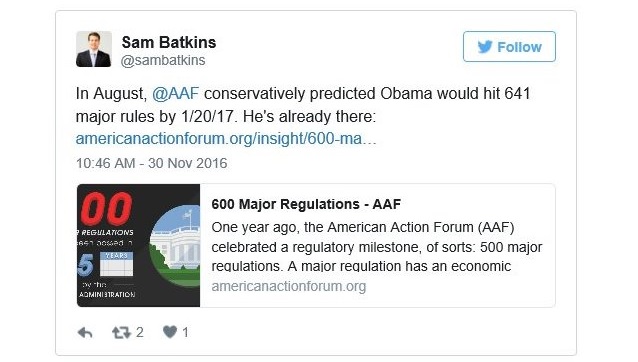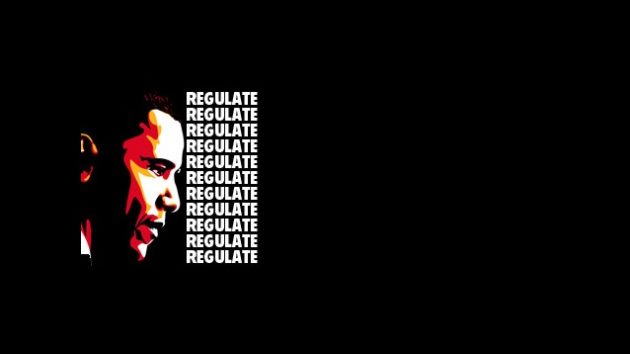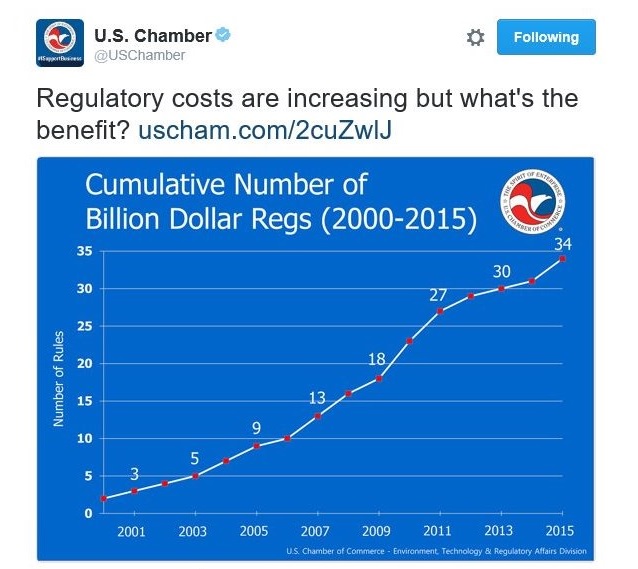Obama’s Regulatory Rush to the Finish Line
Key Takeaways
As many as 98 new major regulations could be finalized before @realdonaldtrump takes office.
When I played football in high school, as the game neared its end–no matter if we were winning or losing–my coach always said, “Finish strong.” He didn’t want his players to leave anything on the field. He insisted we play with the same intensity in the fourth quarter as we did in the first.
As he ends his term, President Barack Obama is coaching the agencies under his watch with the same sense of urgency. And like my old football coach, he’s getting the same response, Politico reports:
Regulations on commodities speculation, air pollution from the oil industry, doctors’ Medicare drug payments and high-skilled immigrant workers are among the rules moving through the pipeline as Obama’s administration grasps at one last chance to cement his legacy.
[ … ]
As many as 98 final regulations under review at the White House as of Nov. 15 could be implemented before Trump takes office. Seventeen regulations awaiting final approval are considered “economically significant,” with an estimated economic impact of at least $100 million a year.
One agency who is taking this direction to heart is EPA. After the election, Administrator Gina McCarthy used an athletic analogy of her own in a pep talk email to her staff:
As I’ve mentioned to you before, we’re running — not walking — through the finish line of President Obama’s presidency. Thank you for taking that run with me. I’m looking forward to all the progress that still lies ahead.
By “progress” she means more regulatory red tape.
The regulatory rush is at full speed. The Interior Department finalized a rule to reduce methane emissions during oil and natural gas production on federal lands, even though methane emissions in the energy sector have fallen as natural gas production has risen. Energy groups immediately filed suit to stop it.

The Interior Department also released an offshore energy development plan that blocked portions of the Arctic from exploration.
Financial regulators are also doing their best to write as many rules before the next administration takes office, Reuters reports:
Some rules are meant to flesh out the Dodd Frank Act of 2010 designed to prevent the next global financial crisis. Trump campaigned on a pledge to scrap the law but now he says only some provisions must go to lighten the regulatory burden.
The Federal Reserve is working on rules to govern matters such as executive pay, market stability and what investments Wall Street may hold.
Last month, Securities and Exchange Commission Chair Mary Jo White said her agency would “in the near term” finish a rule on one thorny issue: how mutual funds manage derivatives.
The SEC and bank regulators have also for years struggled to finalize a rule that would tie more banker pay to the long-term health of their firms rather than short-term performance of Wall Street firms.
It’s all hands on deck throughout the regulatory apparatus, Reuters adds, “Some sixteen copy editors [at the Federal Register] are due to forego leave and be on hand in the coming weeks to process final rules expected from dozens of agencies, said an official familiar with the operation, but not authorized to speak to the media.”
To put the Obama administration’s regulatory barrage into some context, according to the American Action Forum, through the final November of his administration “President George W. Bush had issued 462 major rules. By contrast, President Obama has issued 636, or 37 percent more than his predecessor.”
Congress does have some say in this rules rush. The Congressional Review Act gives Congress and the president an opportunity to block regulations up to 60 days after they were written. However, the law can only be used on one regulation at a time.
To give Congress more flexibility, a few weeks back, the House passed the Midnight Rules Relief Act, supported by the U.S. Chamber. This bill would package multiple regulations together under the CRA. According to the Chamber’s letter to House members, this would reduce “the risk that a poorly-written rule escapes CRA review because there is not enough time for separate debate and votes on each rule.”
One thing is for sure, the “strong finish” by President Obama’s regulators could keep the next Congress and administration very busy.
More Articles On Regulatory Reform




Leave a Reply
Want to join the discussion?Feel free to contribute!